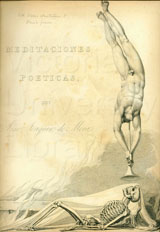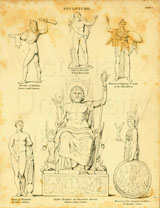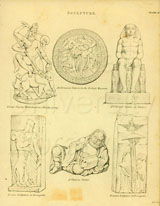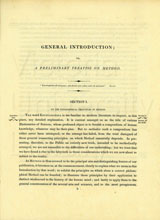The exhibit includes a South American response, published during Blake’s lifetime, to his very successful designs for Robert Blair’s poem The Grave.
The preface explains that the poems of Mora were especially written to interpret Blake's designs for Blair's Grave.
José Joaquín de Mora. Meditaciones poéticas.
Londres: Lo publica R. Ackermann ... y en su establecimiento en Megico, asimismo en Colombia, en Buenos Ayres, Chile, Peru, y Guatemala, 1826 (Impreso por Carlos Wood).
Abraham Rees (1743–1825), Presbyterian minister and encyclopaedist, was led by his interest in mathematics and the physical sciences to re-edit Chambers’s Cyclopaedia of 1728; so successful was the first version of 1778 that Rees undertook a more comprehensive revision that became known as Rees’s Cyclopaedia. The work was completed in August, 1820, with the issuing of six half-volumes of plates. Rees was assisted by about 100 contributors, most of whom were nonconformists as well as eminent specialists in their fields. Several of the contributors were radicals. At a time when philosophical radicalism was highly suspect in Britain, aspects of the Cyclopaedia were considered subversive by the loyalist press. In the difficult years following the failure of his 1809 exhibition, engraving for the Cyclopedia was an important source of income for Blake.
Disbound plates engraved by William Blake for Abraham Rees.
For Rees’s Cyclopaedia, or Universal Dictionary of Arts, Sciences, and Literature.
London: Longman, Hurst, Rees, etc., 1820.
Abraham Rees (1743–1825), Presbyterian minister and encyclopaedist, was led by his interest in mathematics and the physical sciences to re-edit Chambers’s Cyclopaedia of 1728; so successful was the first version of 1778 that Rees undertook a more comprehensive revision that became known as Rees’s Cyclopaedia. The work was completed in August, 1820, with the issuing of six half-volumes of plates. Rees was assisted by about 100 contributors, most of whom were nonconformists as well as eminent specialists in their fields. Several of the contributors were radicals. At a time when philosophical radicalism was highly suspect in Britain, aspects of the Cyclopaedia were considered subversive by the loyalist press. In the difficult years following the failure of his 1809 exhibition, engraving for the Cyclopedia was an important source of income for Blake.
Disbound plates engraved by William Blake for Abraham Rees.
For Rees’s Cyclopaedia, or Universal Dictionary of Arts, Sciences, and Literature.
London: Longman, Hurst, Rees, etc., 1820.
In the decade before 1820, encyclopedias were a prominent feature of the publishing landscape. Coleridge, dissatisfied with the encyclopedias he knew and interested in the theory behind the genre, agreed to plan and to supervise a new encyclopedia proposed by publishers Fenner and Curtis in the spring of 1817. By the time he had provided the prospectus, however, Coleridge’s uneven work habits were apparent, and Fenner and Curtis asked him to work under supervision. Coleridge rejected this proposal but agreed to write the Introduction, which was published in January 1818--though in such a mangled form (in his own view) that Coleridge felt obliged to rewrite it for a new edition of his periodical The Friend later that year. The Encyclopedia Metropolitana was finally completed in twenty-eight volumes in 1845.
Samuel Taylor Coleridge. General Introduction; or a Preliminary Treatise on Method. For Encyclopedia Metropolitana.
London: Fenner and Curtis, 1818.









